 Or perhaps the Manifesto of the Communist Party. Whatever; it is mercifully short, though even so about half of it could have been removed, being merely preamble; it's a quick run-through of the analysis of Capital, I presume, so that you know the Victory of the Proletariat is inevitable; oh, goody. We've owned the thing time out of mind but despite it's shortness I don't think I've bothered read it before; and without Popper's TOSAIE I doubt I'd have got through it, or understood it, this time either. The backdrop, incidentally, is Hugh Gaitskell's "Soc+Nat", doubtless equally enthralling, that I hope to get to next. See what cleaning under the bed gets you? Onwards.
Or perhaps the Manifesto of the Communist Party. Whatever; it is mercifully short, though even so about half of it could have been removed, being merely preamble; it's a quick run-through of the analysis of Capital, I presume, so that you know the Victory of the Proletariat is inevitable; oh, goody. We've owned the thing time out of mind but despite it's shortness I don't think I've bothered read it before; and without Popper's TOSAIE I doubt I'd have got through it, or understood it, this time either. The backdrop, incidentally, is Hugh Gaitskell's "Soc+Nat", doubtless equally enthralling, that I hope to get to next. See what cleaning under the bed gets you? Onwards.Sunday, 31 January 2021
Book review: The Communist Manifesto
 Or perhaps the Manifesto of the Communist Party. Whatever; it is mercifully short, though even so about half of it could have been removed, being merely preamble; it's a quick run-through of the analysis of Capital, I presume, so that you know the Victory of the Proletariat is inevitable; oh, goody. We've owned the thing time out of mind but despite it's shortness I don't think I've bothered read it before; and without Popper's TOSAIE I doubt I'd have got through it, or understood it, this time either. The backdrop, incidentally, is Hugh Gaitskell's "Soc+Nat", doubtless equally enthralling, that I hope to get to next. See what cleaning under the bed gets you? Onwards.
Or perhaps the Manifesto of the Communist Party. Whatever; it is mercifully short, though even so about half of it could have been removed, being merely preamble; it's a quick run-through of the analysis of Capital, I presume, so that you know the Victory of the Proletariat is inevitable; oh, goody. We've owned the thing time out of mind but despite it's shortness I don't think I've bothered read it before; and without Popper's TOSAIE I doubt I'd have got through it, or understood it, this time either. The backdrop, incidentally, is Hugh Gaitskell's "Soc+Nat", doubtless equally enthralling, that I hope to get to next. See what cleaning under the bed gets you? Onwards.Saturday, 30 January 2021
Book review: Across Realtime
Two in one: The Peace War, and Marooned in Realtime. Both are good; the sweep of vision makes MiR better. This is my second read: while I remembered the story vaguely I'd forgotten all the details - it has been gathering dust on my bookshelves for decades - including, fortunately, whodunnit in the second.
The first is an exciting unlikely-cast-of-underdogs-defeat-evil-govt adventure story. The second is effectively a whodunnit, but set across a wonderful background.
I don't propose to go over the plots, since you'll find those elsewhere or, better still, just read them; so I'll assume you know those.
The most obvious flaw in TPW is having Rosas betray the biofolk to the Peace; despite the excuses attempted, this isn't convincing. And to compound that by having Wily denounce Rosas and Lu and, incredibly, for no-one to even bother investigate is utterly implausible. Somehow their operation was discovered, they have no interest in finding out how; mysteriously, those three escape, they show no puzzlement at all; and these people are supposed to be paranoid survivors? And it seems pointless: the denouncement could simply have been skipped.
The more interesting flaw, though, is the problem of a bunch of bureaucrats taking over the world (as this Goodreads review points out; it's wrong about the would-bobbles-float, though). I think this wouldn't work on both organisational and practical terms. On practical terms, having your "bobbler" is pretty useless without targetting. Mysteriously, their first "hit" is the returning orbiter, which would have been going really rather fast: you'd need direct access to some military radar, and where would that come from? And how would you extend that worldwide? On an organisational level, I just don't see it: even if you had some evil corporate / bureaucratic core, how would you keep the conspiracy secret, yet wide enough to be active?
TPW apparently lost out to Neuromancer for the Nebula; I would have made the same choice; N is beautiful in a way TPW isn't; while a decent book it is in some respects pedestrian.
MiR, though, raises its sights across 50 Myr. With bobble-tech understood and general tech exponentially increasing, it becomes possible to, effectively, time-travel forwards. Sometime early in the 2200's, though, everyone-else disappears; part of the book is speculation (aliens? Singularity? War?) about what might have made everyone vanish. And so we're left with a small cast of survivors: people who have accidentally or maliciously been bobbled forwards; those who deliberately left.
For the sake of the story, it is necessary that those who remain be few in number. This doesn't seem plausible. Faced with the chance of "going forwards" so easily I bet many many would take it: millions more than thousands, certainly not the handful that VV permits.
But this gives us some grand scenes: the opening, where countless megatonnes of nukes liquify the crust to release a long-buried bobble; the guy who survives falling into the sun; spacecraft propulsion, by setting off a nuke behind a precisely-controlled bobble shell. And, relatedly, the possibility of exploring the galaxy, slowly in realtime, but with "not much" subjective time. Though he has allowed himself indefinite life extension via bioscience too.
Again, it is odd (or would be odd; it is perhaps necessary for the story) that so few people chose to explore the galaxy, in an assumed world where the tech to do so was within ordinary reach. This is a commonplace of such books: one of the characters, as background, mentions having found the ruins of alien civilisations. Casually, in conversation. But no-one follows up. What has been said, has never been written down. WTF? It just isn't even faintly believeable.
As an aside, the casual throwaway penetrating-everyone's-computers is about as accurate as Neuromancer's view of cyberspace.
And in the end, the villains are a bit dull; but perhaps that isn't the important bit; the important bit was the finding them.
Sunday, 24 January 2021
Old Tee Shirts
* old ones;
* rowing ones;
* beer festival;
* running.
Every marathon and most half-marathons nowadays "give" (i.e., you pay for it via the entrance fee) you a tee shirt. So I have 15 or so marathons, and I gave up counting and keeping the halves quite a way back. Anyway, you get the general picture: too much stuff.
The problem is the old ones, which come with too many memories, and are hard to get rid of. So I have compromised and photographed them. And this post collects them.

Bought, astonishingly enough, in Norway during the Anglo-Danish Friendship Expedition to Finse in the early 90's. Probably for M, but she doesn't wear such any more. Completely worn out at the collar.

From the Rotterdam Marathon, 2016. A nice T, though that wasn't a vintage race for me; but I failed to keep it clean.

Boston Marathon (rowing); I'm unsure of exactly which year; perhaps 2015. I have others.

This is still a perfectly decent T, not worn because not much worn, because I didn't like it. Not for the pattern, which is fine (note that the bg colour here it quite wrong: really, it is purple) but because it was too stiff and never softened.
Thursday, 21 January 2021
The book of the old year: 2013
March: Dover Castle
April: Brighton marathon - my first quasi-respectable time.

May: Stanage, Youth - featuring Daniel.
The welcome return of the bees.
June: ?

July: Rowing: bumps
Stubai
August: Rowing: Peterborough and my point
Wot we did on our holidays.
September: Rowing: Boston (and part 2)
October: Amsterdam marathon - even closer to a respectable time. I'll get there (3:30) one day I hope. With Miranda, though she didn't run.
December: Miranda gets her grade 4 piano with 80/100, which is a merit. We draw a discrete veil over an earlier episode. grade 4 clarinet is next summer.
Book review: the Cadwal Trilogy: Araminta station; Ecce and Old Earth; Throy
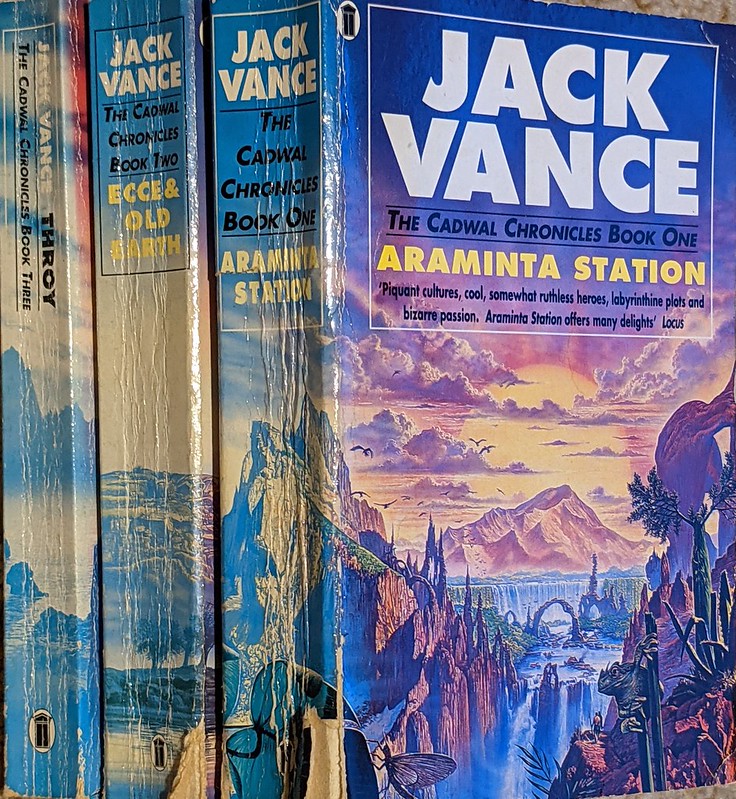 I've been reading Vance for a while now; I've read these ones at least twice before. Occasionally, when wondering what to read, I've glanced over the shelves, seen these, and think "nah, I can recall the story too well" and passed them over; but enough time has passed that I can now re-read them. There's a review here; Goodreads also likes it. When "reviewing" Planet of Adventure I see I compared it to Cadwal; and yet I think I was somewhat wrong; PoE is better, in that shorter, and more compressed; these, while good, do go on a bit. So, whilst good, not his finest.
I've been reading Vance for a while now; I've read these ones at least twice before. Occasionally, when wondering what to read, I've glanced over the shelves, seen these, and think "nah, I can recall the story too well" and passed them over; but enough time has passed that I can now re-read them. There's a review here; Goodreads also likes it. When "reviewing" Planet of Adventure I see I compared it to Cadwal; and yet I think I was somewhat wrong; PoE is better, in that shorter, and more compressed; these, while good, do go on a bit. So, whilst good, not his finest.Monday, 18 January 2021
House: foiling the loft
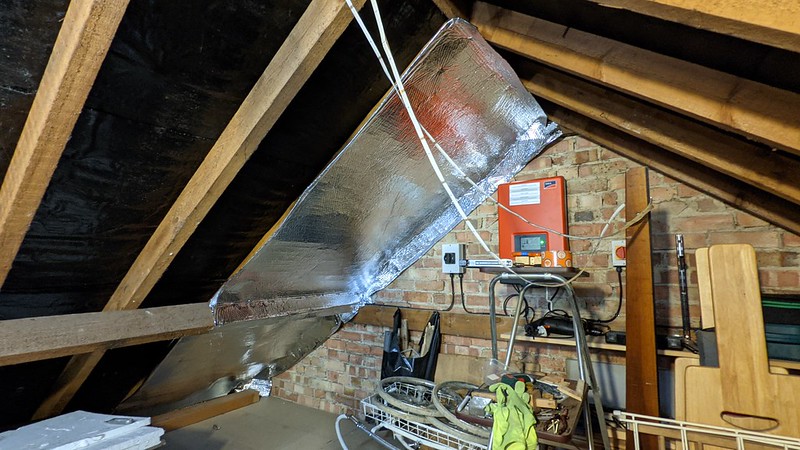
That was Saturday. On Sunday I decided to do some more, so went back to B+Q and got two rolls of 7 mm stuff (£55 each), 14 m long and 1.2 m wide. But roof-to-edge only needs 3.5 m, so 14 m is good for 4 groups with no waste, I hope. Here is it's info sheet, and a pic of the roll.
It is somewhat awkward getting it straight in a confined space with only one person. Stapling it on goes easily enough. There are a few wires to avoid... here's where the solar panel wire comes in, garden side. I've written on the insulation where it is. There are some "before" pix on the garden side; and on the road side which shows the solar wire, if you look closely; more detail. The thicker stuff seems more awkward to handle.
Notice that I haven't "finished off" at the bottom, or against the brick wall: I'm not sure what I'm planning to do there, so have left it for the moment. Also, I haven't taped the seams.
Here's a bit further, showing the wrapping around the beams (should I do that?) and how I had to cut it to get around the cross-beam (all the Youtube videos of how to do this stuff don't mention that, oddly).
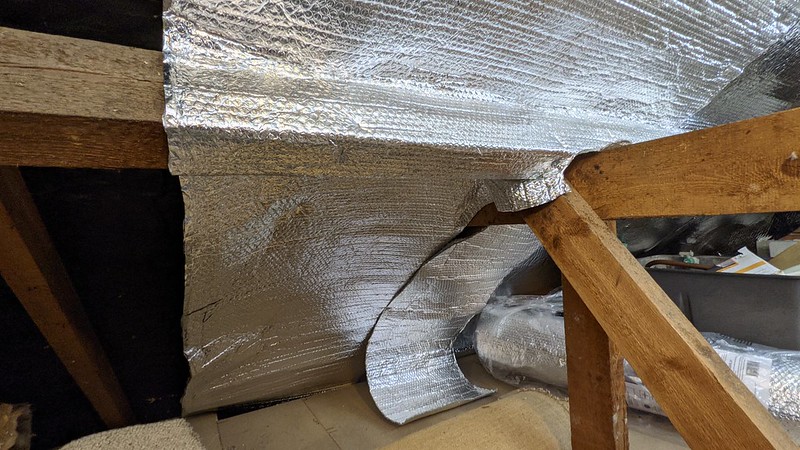
Going around the vertical and evading my new wires was a bit of a pain, too.
And looking the other way, road side:
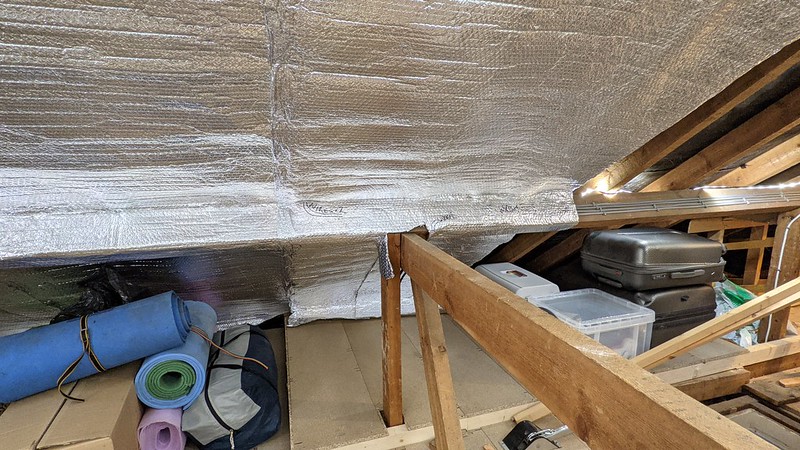
There are some electricity wires under there; I've written on the foil where they are.
[2021/01/30] It's been a quiet week. Today I did another panel's worth, on the garden side, level with the chimney. General view. I also unrolled one of the rolls of carpet:

It is more useful, and less in the way, that way. I also put the foil behind the light-fitting; which isn't in use at the moment cos the LED light is better and doesn't dangle down. Although note to self the socket is live: it is where the multi-block power is drawn from.
Meanwhile in the living room I replaced the ceiling rose which was old and dirty.
I've now (2021/02/14) done one more strip, by the loft hatch. Upwards view. I've marked on the wires.
Saturday, 16 January 2021
House: things put in the loft
Gosh, how exciting. And, obvs, of no interest to most of the world. But hopefully a useful reference for me. So, the loft is now in a state where I can actually put some stuff up there, though it is by no means finished.
Area A (somewhat raised portion, road side, near hatch)
* Blacks "Calder" tent. D's new 3-person tent. Roll of carry-mats, x2. Old (ex-BAS) walking axe. Cat box.
* Large suitcase. Medium suitcase. Roll and box of bubble wrap (that were already up there). Roll of thin purple foam.
* [Pic] Cooler box for back of car. Red metal box of Pre-School files, circa 2001. Robust plastic travel case, ex UPF from CSR, with some spare little metal boxes inside.
* [Pic] My old very-non-waterproof rucksac, with the nice blue rope and the stiff green rope in it. The snowshoes Rob got from Canada. A wooden deckchair, ex Mfd+J (another up there is open to sit on).
* My BMW motorcycle helmet.
* [Pic] More climbing stuff: the "big black bag"with ski sticks, ice axes (tech x2, Ghost x3, walking x1), crampons (x3).
* [Pic] The "foot wheel" things that were nicely made but we never used. Daniel's old trolley-for-blocks.
* A small wooden "chest of drawers". The wooden box with the Green Party logo I painted on it; empty. My old yoga blocks. The purple plastic-boot crampons.
* A cardboard box with cameras: my old Praktika MTL5 plus 200 mm lens; the Nikon F-801 with Mirror 500 mm lens.
* [Pic] Portable BBQ. "New" camping ETApower gas stove. Old Trangia. Yellow washing-up bowl with misc camping-cooking bits, including spare cans of gas. [Pic] Red (ex sleeping bag) bag with bits including tiny screw-on stove, partly used cylinder and blue plastic mug.
* Big empty clear tub suitable for putting honey in.
* Clear box of old tee-shirts with green lid.
Sunday, 10 January 2021
Book Review: The Silver Chair
From the Voyage of the Dawn Treader I've moved onto The Silver Chair. This one I thought rather better. The start is perhaps a little slow, and Aslan carefully setting them up to not recognise Caspian was rather unfair; and given the way things turned out it rather seemed like that was the better option anyway.
But the trek to the north is quite well done, the Marsh-Wiggle is good, the underground is well done and carefully avoids detail. In contrast to many a wordier epic, and rather like TLTW&TW, the story is quite compressed, and he does not allow himself the indulgence of excess detail and diversion.
The somewhat-mysterious Witch figure is a little odd: she is poison-green, and so not the White Witch. The characters explain her to themselves as "another of the same sort" but there's no explanation for her presence. Jill and Eustace, as expected, grow during the story. The Marsh-Wiggle doesn't. But then he is of faerie.
You'll complain that in this review I've said very little and it was barely worth writing this down. I agree. I'm only doing it as a record of having re-read it.
Saturday, 9 January 2021
Book review: Rowan Williams, The Way of St Benedict
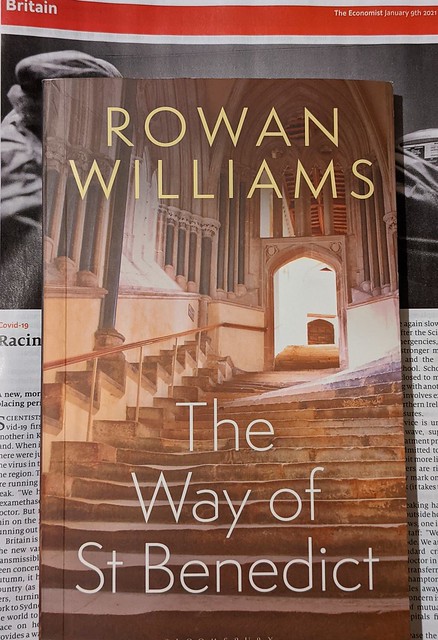 Weirdly, calling it "The Way of St Benedict" didn't trigger "Benedictine" to me at all. Given to us for Christmas by J. The cover shows "the worn steps leading up to the Chapter House, Wells Cathedral" and this is very much how I envisage the book, and Dr Williams: in an old but immaculately clean and maintained stone building, dimly arched above but nonetheless filled with light; sonorous; we are perhaps in his book-lined study, or in the SCR with old portraits looking down; the discussion is serious and reverential; people agree, or disagree politely. The bits of the book that fit this are a pleasure to read and can be said to work. The bits that attempt to go out into the real world are a failure. My picture subtly hints at this; the background is The Economist on Covid. You might like to read the Church Times review. Skimming wiki's Rule of Saint Benedict and finding the motto of the Benedictine Confederation: pax ("peace") and the traditional ora et labora ("pray and work") my feeling is that RW has been somewhat selective in what he has taken from The Way; but, it is his book.
Weirdly, calling it "The Way of St Benedict" didn't trigger "Benedictine" to me at all. Given to us for Christmas by J. The cover shows "the worn steps leading up to the Chapter House, Wells Cathedral" and this is very much how I envisage the book, and Dr Williams: in an old but immaculately clean and maintained stone building, dimly arched above but nonetheless filled with light; sonorous; we are perhaps in his book-lined study, or in the SCR with old portraits looking down; the discussion is serious and reverential; people agree, or disagree politely. The bits of the book that fit this are a pleasure to read and can be said to work. The bits that attempt to go out into the real world are a failure. My picture subtly hints at this; the background is The Economist on Covid. You might like to read the Church Times review. Skimming wiki's Rule of Saint Benedict and finding the motto of the Benedictine Confederation: pax ("peace") and the traditional ora et labora ("pray and work") my feeling is that RW has been somewhat selective in what he has taken from The Way; but, it is his book.Here's a nice quote from the intro:
The chapters in this little book will, I hope, help to flesh out in various ways something of the appeal of Benedictine life. It speaks to people of the extraordinary power of stability - not a static and frozen style of life, but a solid commitment to accompany one another in the search for a way to live honestly and constructively together in the presence of God. This stability is expressed in the habitually prosaic language of the Rule: it is about acquiring 'tools' for living accountably alongside others, for learning how to pay attention to others, for identifying and rectifying your own unthinking self-centredness. The undemonstrative, practical climate of the Rule has a particular attraction whenever talk about the spiritual becomes cloudy, elevated and unspecific. It is a good Benedictine principle that the call to common-or-garden faithfulness to one another has to be answered before there is any talk of supposedly higher callings: committed life together matters more than any individual search for spiritual fulfilment. But at the same time, that life together is the solid foundation for growth into intimacy with God, into what people call the 'mystical'; Benedict, in a typically low-key way, ends the Rule by gesturing towards the more radical adventures for which the teachings of the Desert Fathers and Mothers prepare the spirit. His point is simply that unless you have got yourself accustomed to the 'toolbox' of daily attention to the awkward reality of human others, the search for deeper intimacy with God will lead to destructive illusion.
That all reads well. For me, there's an awkwardness at the end of that passage: as an atheist, I have no God. This, I suspect, undermines my understanding of their fundamental point. If it helps you to understand me: when I think of this, and imagine myself quietly living out my dotage in a monastery - which often seems like a rather appealing idea, as I kinda imagine it like college cloisters - or like Anathem - then I think of myself as contemplating quantum mechanics. Or perhaps Lisp.
To illustrate the kind of things the book doesn't provide: I found myself wondering, if the monastic life (TML) and rule is so good, isn't it a regrettable failing of the Christian life that it isn't available to everyone? Do we see TML as better than "normal" life? Sometimes it seems like he does think this, but of course can't say so; but we get images of it "illuminating" normal life; or helping to keep the Church on track. P 30 has "the monastic life as a sharpening of the focus that exists in all Christian life" - this I think is his thinking, and makes sense if you go along with it, but doesn't actually have a clear meaning.
Part of TML is obedience to the abbot. RW speaks of this as though it were absolute; and perhaps it is; but that power would be corrupting to any mortal, and I don't think he explores problems with that. It also places huge burdens on the abbot, and RW just assumes that these will be borne ("he is accountable to God", says RW, which may satisfy the religious). This, on reflection, is rather close to Plato's philosopher-kings, who will make wise decisions; Popper I think decisively destroys this as idea but RW shows no awareness of this. As you can tell, I'm interested in issues of governance; RW isn't; they are to him an awkward side-issue from holiness, his main concern.
Stability was in the intro and is in chapter two: The Rule of Benedict is, in one sense, all about stability. That is to say, it's all about staying in the same place, with the same people. The height of self-denial, the extreme of asceticism, is not hair shirts and all-night vigils; it's standing next to the same person quietly for years on end. This is an interesting aspect, and a contrast with our outside world, where we are accustomed to change - or to attempt to change; or to be told that if we only vote for X then they will change for us - things that we don't like. I think however that this somewhat drops out when he comes on to talk about The Real World, later. And I'm mostly interested in how this could play out in TRW.
In contrast to stability of TML, RW comments we currently live in a world of almost unimaginable financial instability. We have created a seemingly unmanageable engine of chaotic change, governed by a small elite who will determine the patterns of international institutions; but this is not true. Is is a common leftist-progressive trope, and I'm sure whenever RW says it at nice dinner parties all the nice people attending duly nod their head an agree; but he needs to broaden his circle of acquaintance. Happily, RW has no answers to this problem and indeed nothing to say on the subject, so he soon drops it.
Chapter 3 fragment: "The truth of any ideas or doctrines is something that becomes apparent in the light of the sort of life that those ideas make possible". Accustomed as I am to a scientific worldview, this seems false. Even of philosophical ideas, it seems dubious. And I'm fully prepared to believe that people can lead good lives through belief in God, even though I think they're wrong. So I think I'm forced to fall back on him using "truth" is what I'd consider an odd way; perhaps "proof" would be better.
Chapter 5 attempts to take the Word out into the World. We discover that Outside, Time is an undifferentiated continuum in which we either work or consume. Work follows no daily or even weekly rhythms but is a 24-hour business. WTF? Was has he been smoking? After a bit he seems to realise that he's talking nonsense, because he adds "At least, that is the message regularly given by advertising and popular fictions" but really, he's off the rails and needs to just delete this bit. Or get some better editors.
In attempting to address Europe's problems he ventures onto migrants: to pick up point that is especially pertinent in our present situation, it would be one that did not panic about migrants. The migrant group that is prepared to work within the civic framework of a host society, that aspires simply to citizenship, is one whose voice in the community overall is of significance alongside those who have a longer history and a political or economic advantage. Once within the relationships of purposeful common life, the facts of coming from ethnically or religiously different backgrounds should not disenfranchise them. But this, whilst splendidly tolerant, really doesn't address any issues in any useful way. Could he perhaps have considered the analogy with a monastery? What would such do, if confronted by a group outside its doors, demanding admittance and attempting to scale the walls? He doesn't even consider this, and indeed he doesn't have any answers, offering only that "the way is open to a properly 'Benedictine' questioning" - but this is the approach of the academic, who has a scholarly interest in questions, because revolving possible solutions to questions is a fascinating intellectual pursuit.
Name checking Hegel favourably loses him points; refer to The Open Society and Its Enemies if this isn't immeadiately clear to you.
While I'm nearby, one of the abbot's tasks is to find the sort of labour appropriate to the capacity of each is perhaps appropriate in the small world of the monastery, but a poor model for govt; see Hayek. It isn't clear if RW is just being somewhat careless here, or isn't aware that the monastic order really can't scale up.
How am I to read work is the sustaining of a properly human and intelligent corporate ecology? Does the word "is" imply that what follows it, is a definition of the word "work"? If so, it seems idealistic. It might be what we desire work to be, given that most people spend large parts of their day doing it. The text may be referring back to an earlier A civilized life structured around the vision of the Rule is one in which economics is not allowed to set itself up as a set of activities whose goals and norms have no connection with anything other than production and exchange. This is a rather primitive or left-wing view of economics. Economics is the study of people's choices. In the free market model, they get to choose their own goals; I feel that RW would like them to choose better, and perhaps nudge them more or less powerfully to ensure this; fortunately, his abbot is not only Good but also Powerful, so nothing could go wrong with this. Elsewhere, he recognises the "centralising and impersonal pull of bureaucracy" but has no ideas of how to counter it. A little later he bashes globalisation, without of course noticing its role in bringing people out of poverty.
And how on earth did he come to write If the Rule is to be one of the sources for the conservation and renewal of European civilization in the centuries to come - granted that these centuries may be every bit as brutally anti-humanist as the so-called Dark Ages..? This is also somewhat odd: We cannot take it for granted that any political order, European or otherwise, will regard it as a priority to make possible a life of contemplative delight in God the Father. Indeed, I think we can be pretty sure that this will not happen. Hopefully that won't interfere with his programme too much.
Anyway, I think that gives you an idea of the book and my reactions. That covers part 1. As TLS notes (fortunately just before we hit the paywall), These pieces occupy two-thirds of the book. The remaining third reprints, with changes, two considerable essays written decades ago. I found them somewhat less interesting, only skimmed them, and will not attempt to review them.
Monday, 4 January 2021
Book review: the Voyage of the Dawn Treader
As a film night, we recently watched The Chronicles of Narnia: The Voyage of the Dawn Treader; and so I've re-read CS Lewis's book. My verdict is that it is... OK, but a bit... pale? Perhaps even sickly? Everything is just too nice, except early-Eustace, and he isn't enough.
The story has some nice elements, and is well crafted. But... Aslan is too much, or too obviously, in charge? For example, when Caspian wants to go off the end of the world, and can't due to duty, and sulks, Aslan "has a word" with him, and he stops sulking. But the point is that he's already accepted that duty says he can't go; all Aslan has done is stop him sulking; that seems like waaay overkill. And of course appearing as a lamb that changes into a lion is just a touch unsubtle.
The voyage on the ship is nice, but the sailors, while they play their background part, are not really human beings in the story, which remains relentlessly if perhaps inevitably focussed on Our Heroes, who wander off whenever they feel like.
Amusing note: in TLTWATW, Miranda noticed that whenever he says "...went into the wardrobe" he is careful to add "...and didn't close the door, because everyone knows that is a bad idea". But in this one, at the Dark Island, he compares the darkness to going deeper and deeper into a railway tunnel, and doesn't tell you that going in there is a really bad idea.
Refs
Saturday, 2 January 2021
House: flooring the loft
The loft is a foreign country... well, at least partly. Years ago I put some nice pine boards down over half of it, but the other half - the side near the neighbours - was neglected, and is a pit of dust and spiders, though it has the inverter for the solar system on the dividing wall. Anyway, for <reasons> I got all enthusiastic and decided to board it. Having observed a video or two on Youtube I realised that the govt's guidance for insulation is 270 mm; I have a nominal 100 at the moment, but it was put in rather shonkily by the previous inhabitant, probably at the behest of his wife, because he didn't bother finish behind the chimney breast and hid a few rolls of spare insulation there.
Most of the point of this post is to link to pix I took of the work, so that later I can find all the pipes and wires that got hidden.
We begin with "before". the water pipes are from rework in 2006ish. The old insulation really is grey, mostly, though it's also covered in dust. View off Lwards, from slightly forwards. Note old wasps nest remains, which I cleared away.
Cost so far is: £32 + 35 + 120 + 122 + 170 +135 + 98 + 18.
Example: £122 was Eko base layer loft ins x2, 38; 4x1 x4, 23; chipboard loft floor 3 pack x4, 35. Plus some bits. £98 was 2 more chipboard packs o' 3; two jigsaw blades; another 4 x 4x1; one 2x3; omre screws (50 x 3.5x50).

I refreshed the insulation with some pink stuff that was lying around, and raised the level 10 cm with some 1 x 4's (lighter than 2 x 4 but slightly awkward as not so wide). Note cut-outs for the pipes. The insulation goes not-quite-to-the-edges, as I understand this is required for ventilation.

* Looking back the other way, the wires that lead down to Miranda's main light. More context.
So now, infill the extra 10 cm height with (old pink) and (new white / grey) stuff, and then put 18 mm 48" chipboard on top. It is a bit of a pain getting started and getting a platform that can be stood / sat on stably without risking going through the ceiling.
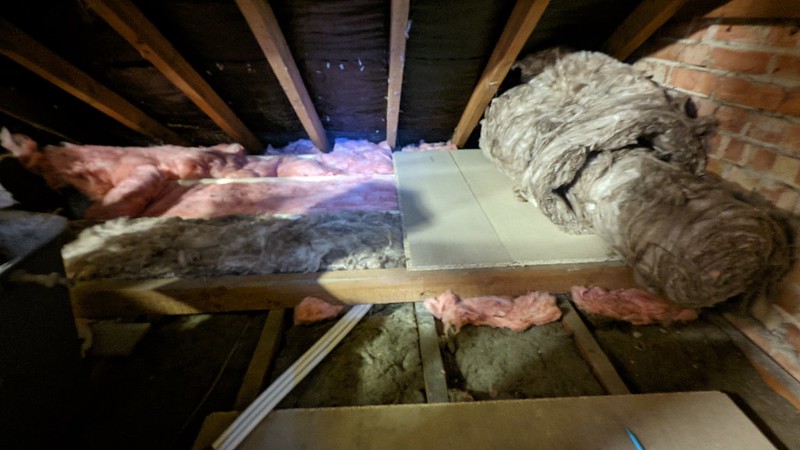
At this point I've run out of <stuff>, principally the 1 x 4, so it is back to B+Q for some more.
* View of the middle, showing some wires...
Here's how I left it at 7 pm on Saturday. I've got form one side into the middle. The big grey box is the old water tank that needs removing. Notice that I am (humiliatingly) using a corded drill with a - gasp - keyed chuck. That's because my stupid deWalt charger refuses to charge my generic replacement battery.
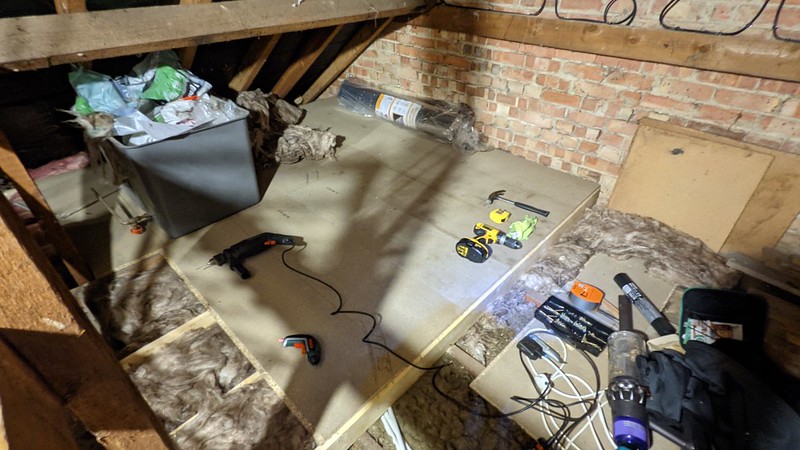
The Next Day: Sunday
That was Saturday. Sunday is another day. Running an extension lead up from below is tedious, so I connected to the existing light wiring, on the grounds that I'm taking lowish current and not for long, and just plugged in some LED lighting. Headtorch no more! I also got another thing of insulation, this one apparently in "blocks" not a roll (pic of yesterdays; pic of today's showing the blocks), with some thought of using it between the rafters. However it is 18" not 14", and my rafters are somewhat variable between 15 and 17, and it doesn't compress laterally well. It can be cut, but it's a bit of a fuss.
My main beams are awkwardly spaced, so it is just a fraction short to bridge across the middle, so the ones on the R (looking from the loft hatch; the last ones laid today) are supported at the R end by battens. Where the pesky water pipes go is marked on the boards, but anyway there are pix to show.
Here's where I am at the end of the day. A decent amount of usable area now. Next steps are either to go R to the loft ladder or more likely forwards into the slope and get all the way across, which is probably less awkward, and will give me more space to clear other stuff into.
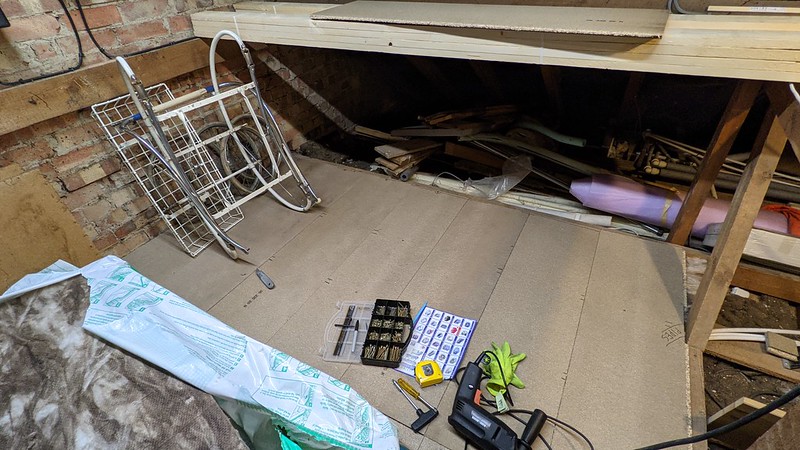
This pic shows the new "block" insulation and it is easier to work with.
The Third Day: Monday
Sneaking in a little work in the lunch hour. Not to spoil the surprise, here's how I finished.
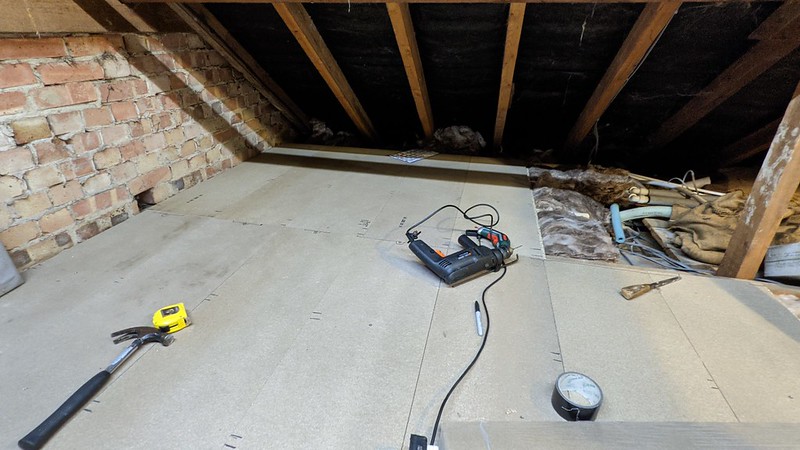
The only interesting "hidden" thing is the wires leading to the ceiling rose in the "laundry" bedroom. You can see those here (or with more context here); and they're marked on the chipboard. Next step is probably to push towards the pipework, if I'm feeling brave. Incidentally, the old underlying insulation wasn't so bad here: it seemed to have been laid better. Nonetheless it was only about 5 cm thick at best, so I still overlaid it with new.
The Fourth Day: Tuesday
Less action today; no new floor laid. Instead I crept gingerly towards the piping. L is towards the center; R towards the road, top towards the neighbours. We're about over the wall separating shower room from small bedroom; indeed I think the wires going down at the L are the ones for the lightswitch in that room. The pipes off the bottom head towards the boiler; those off R head towards the wall and down.

I've lifted some of the wooden planks that were supporting the (now long removed) cold water tank, and removed rather a lot of sawdust, which I think has been there since the construction of the house. Tomorrow I need to extend the new joists (visible at top) downwards, without damaging the pipes.
Fifth: Wednesday
Not much today. Hoovered up more sawdust, considered the pipes a bit. On the "floored" other half, I tidied up and took down the side boards on the street side, in prep for the boilerman tomorrow. My new Ryobi cordless drill turned up.
Sixth: Thursday
The boilerman came today (Compton and Parkinson) and he thought the leak was probably in the boiler, perhaps the pressure relief valve (PRV); if so, that would be good news(as the runoff is onto D's roof). While he was doing that - about 30 mins total - I cleared out behind the chimney somewhat, an area that has been a dumping ground for generations. And then got a couple more boards down. There's a bit of wiring underneath - one fairly neat grey one, you can see it here - but nothing that needed noting.
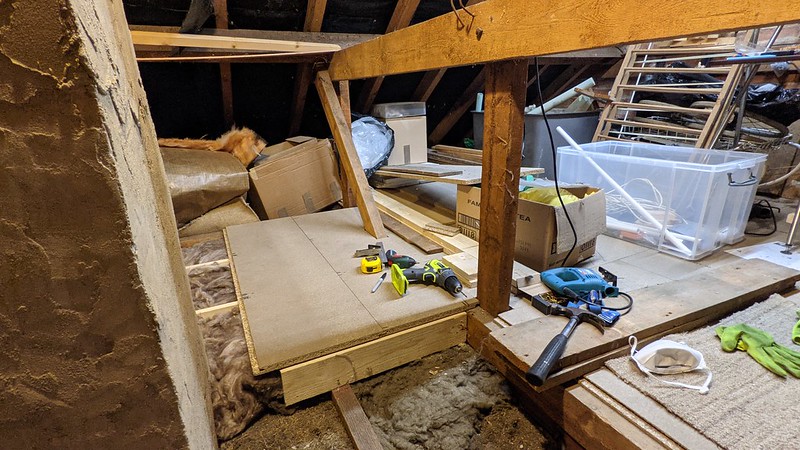
Here are the two new boards - you can also see my new Ryobi cordless. I'm starting to hit the non-linearity of the roof I think; the nearest thing to a right angle is the chipboard, which shows up the wonkiness elsewhere.
Seventh: Friday
I've extended backwards a little from where you can see, towards the garden side.

There's a white/grey wire running across as you see; I've marked it on the board to the R. Note Mfd+J's old carpet which we must have thrown up here some time ago. perhaps I'll actually use it, but for the moment it is annoyingly in the way. Next pic: with the boards on. Notice annoying little gap where the "sticking out" board butts onto the chimney and it seemed easier not to cut it.
I cur the sticking-in "joint" on one of the panels, so it can be lifted once unscrewed, because if I didn't do that you'd have to lift the whole floor from one end. I'm now out of insulation and 1x4s.
Eighth: Saturday
And on. I'm on the garden side, working R to L, now level with the chimney stack, hence the slightly awkward hole you see at the bottom R; I'll probably fill that later. Note that the panel here - you see it says "LIFT" - has had the connector cut. Old carpet abounds. I feel I am nearly at the point where I can unroll it all and have it as a useful addition, instead of being muchly in the way. The old wasps nest is now fully cleared away (that pic also shows the old black, possibly no-longer-live, wire at the back). And I bought some more LED lights to illuminate this bit.

Silliness of the day: using my jigsaw to cut some 4x1 I foolishly cut towards myself... and thought that being 3" from the cut would be fine, but I was careless. No fingers lost, and not much blood.
Ninth: Sunday
Perhaps 3-4 hours worth today. Around the back, on the garden side, I've not got past the chimney.

I think I'll be able to unroll the carpet soon, which will free up more space, which will allow more. Soon, I'll get to the bit I've already floored decades ago, which is going to require re-work, I think. Looking the other way, I've got to the loft hatch, and raised the loft-ladder supports up.

Notice that I somewhat stuffed up the cutting of the board nearest the hatch, but that can be "fixed" by bringing in the one that will go over the pipes, to the L. Once I've worked out what to do with the pipes; it is a bit of a mess. Meanwhile, since there were the parts lying around, there's now some shelves at the back. I'm down to two bits of 4x1 left, so may need another B+Q trip soon.
Monday: not much. Had a look and saw that all was good. Thought about the piping a bit: rather than rearrange it, perhaps I could go to 300 mm and get above it? Could even use the "loft legs" there, perhaps? Also put off doing anything about the carpet. Did remove and bin the old yellow vacuum cleaner, and the stack of microVAX imaging boards.
Tenth: Tuesday
Thinking overnight, I realised I could fix the problem of the mess of water pipes by raising the floor higher there, perhaps to the recommended 270 mm depth of insulation. So, off to B+Q to get some "loftlegs". But! These turn out to be 270 mm tall: not 170, which I'd expected, since the joists are 2x4. I almost buy some anyway, indeed I get as far as putting two cases on my trolley, but then I think again and realise that buying some 2x3" will get me 75 mm just as well. And be cheaper, too. So I do that, and here is the result, or the beginning of same: 1x4, as before, raised 75 mm on 4" of 2x3". the pipes weaving too and fro means that some of the blocks aren't quite in line, but they'll do.

Eleventh: Wednesday
Still at work on the road side. The back joist goes in fine, but the middle one is tricky, due to the pipework. I end up putting in 2/3 of it, but a little further back than it really should be; and then on the L end put in a short one, offset. This, combined with a "DO NOT STEP! WARNING! PIPES!" notice towards the left should serve (though the chipboard is fairly strong and I think you will be able to step there without problems; it's so low you can't, though). There are a few little cuts and adaptions around pipes, but nothing that needs recording.
Twelfth: Thursday the 14th
Continuing on yesterday's theme. First I need to straighten out the bathroom light, since I'll be covering over its wires. This involved vacuuming all the sawdust out near it (remembering all the stuff that fell down into it last time), putting tape over the rough edges, disconnecting the light and taking it downstairs to clean it carefully, attaching some wood strips with hotglue, and sticking it to the ceiling with D's help with same. And it stays there, now making the ceiling look rather dingy. A somewhat awkward view from above; the white box is the transformer.
Attach one of those round wiring-junction thingies to the beam.
And so, here is before (or here), and then after:
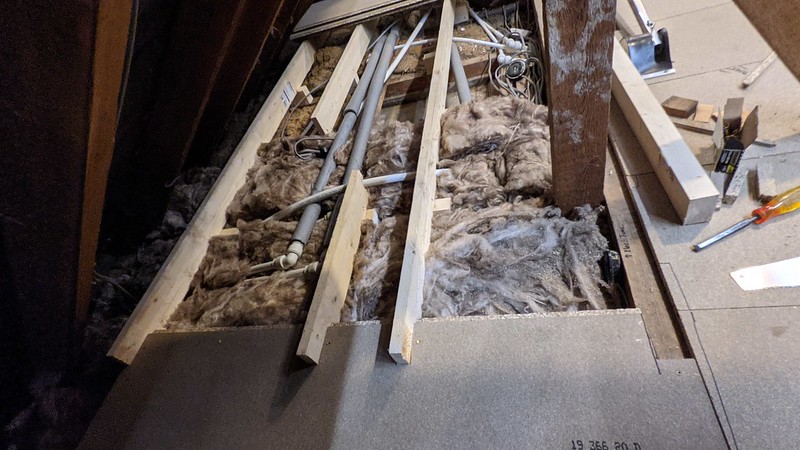
The irregular spacing is obvious but as before I blame the plumbing. This will get an extra cross-layer before the boards go on. BTW, as should be obvious from the earlier photos, all this area is absolutely bone dry.
Thirteenth: Friday the 15th
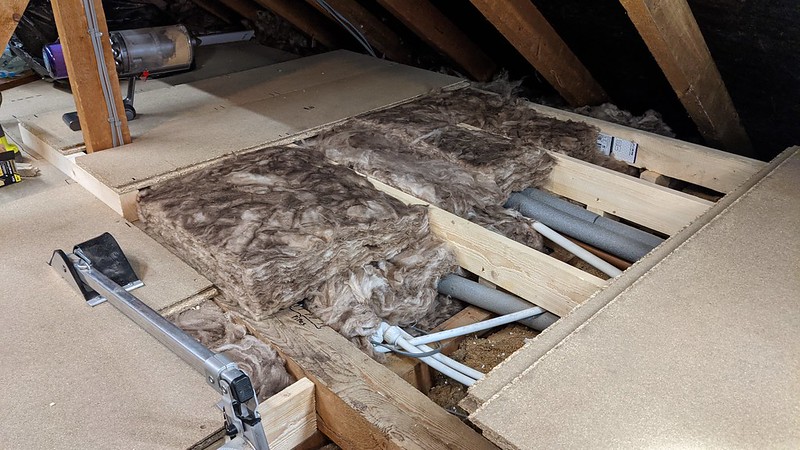
Proceed along, filling and flooring. I've now run out of 2x3, which is why I stopped.
Fourteenth: Saturday the 16th
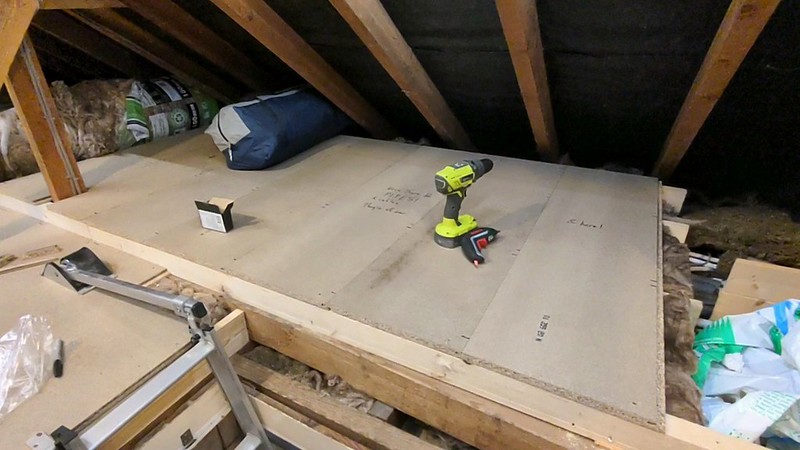
And here we are, with the boards continued about as far as I can, without hitting the next snag, which is the existing boarding off to the R. I think I may have some more to do behind the chimney, but then I'll have done all the boards on this side, and I'll need to decide if I want to re-do the other side where the boiler is, which is nicely pine boarded, but with no insulation.
I want to put some foil rafter insulation up, but at the moment I lack (heavy duty) staples. Also, the question of the carpet arises.
Notice that I've put the big old Blacks' "Calder" tent up there - it is starting to be of use!


